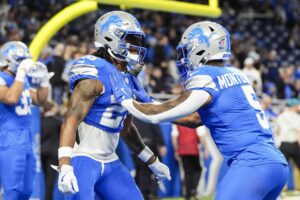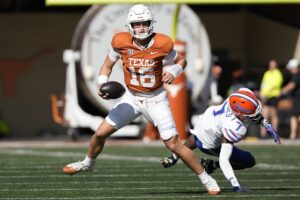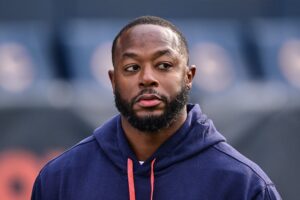Overview
Position: Cornerback
Height: 5’11”
Weight: 201 pounds
School: Texas
Combine Performance Data
40-yard dash: 4.45 seconds
Bench press: 19 reps
Three-cone drill: 6.94 seconds
20-yard shuttle: 4.08 seconds
Kris Boyd 2019 NFL Draft Profile
Football runs in Kris Boyd’s blood, as he’s looking to be the third player in his family to make a career in the NFL. Boyd spent the 2018 season showing the college world that he was one of the hardest-hitting and punishing cornerbacks in football. Playing in 13 games, Boyd finished his season with 15 passes defended, 54 total tackles, 4.5 tackles-for-loss, and one sack. He was one of the best in the country, earning first-team all-Big 12 honors for his performance.
Boyd initially joined Texas as one of the top cornerbacks out of high school. Playing football in his hometown state, Boyd spent his true freshman season as a backup. During his limited time on the field, the cornerback recorded 16 tackles.
Boyd earned a starting job midway through his sophomore season and never looked back. Appearing in 11 games (starting eight), Boyd finished 2016 with one interception, five passes defended, two forced fumbles, and 1.5 tackles-for-loss. While he didn’t earn any national team recognition, his play put him on the national landscape.
Boyd proved his 2016 season wasn’t a fluke with an impressive junior season. Starting in 12 of a possible 13 games, Boyd ended the year with two interceptions, 15 passes defended, and 54 tackles. He once again missed out on national nominations, but his 15 broken up passes led the Longhorns.
Strengths
- a big, physical cornerback capable of winning with toughness;
- impressive ball skills as evidenced by his 30 passes defended over final two seasons;
- improved on an annual basis;
- a smart player capable of diagnosing route concepts and making fast breaks;
- superb tackling technique.
Weaknesses
- underwhelming change of direction ability;
- struggles to make first contact in press coverage;
- cannot consistently close gaps when beaten;
- struggles to cover quicker, faster receivers;
- can get handsy and draw pass interference penalties;
- should have had more interceptions considering how many pass breakups he had;
- might have to transition to safety at the next level.
NFL Comparison: Quentin Jammer
Teams With A Need: Oakland Raiders, Atlanta Falcons, Tampa Bay Buccaneers, San Francisco 49ers, Cincinnati Bengals, New Orleans Saints, New York Jets
Projection: Round three
Bottom Line
Boyd will be a valuable player in this league but it just might not be at cornerback. The 5’11” safety is one of the bigger and more physical players at his position, which is a blessing and a curse. On the bright side, his physicality allows him to maul receivers within five yards of the line of scrimmage, and his ball skills are pretty impressive. He’s gotten better on an annual basis, which suggests he still has room to grow. On top of that, he’s one of the best tacklers at the cornerback position and can take down anyone he’s asked to cover.
Unfortunately, being a large cornerback is a double-edged sword. Thanks to his large frame, Boyd doesn’t have the best change of direction ability. Quicker receivers are able to get off the line against him and Boyd doesn’t have the agility to keep up with them in coverage. This lack of agility shows itself in his deflated interception total. He has the ball skills to break up passes, but not the speed or agility to turn said breakups into turnovers. Because of this, he might be better off learning how to play safety while covering tight ends.
If Boyd is to make it as a cornerback, he’ll need to play in a zone scheme. He has decent straight-line speed and above-average recognition, two traits needed to excel in zone coverage. However, even if he has to play safety, he’ll still be a valuable player. Look for Boyd to carve out a solid career as either an average starter or a high-end backup in an NFL secondary.
Main photo:
Embed from Getty Images






